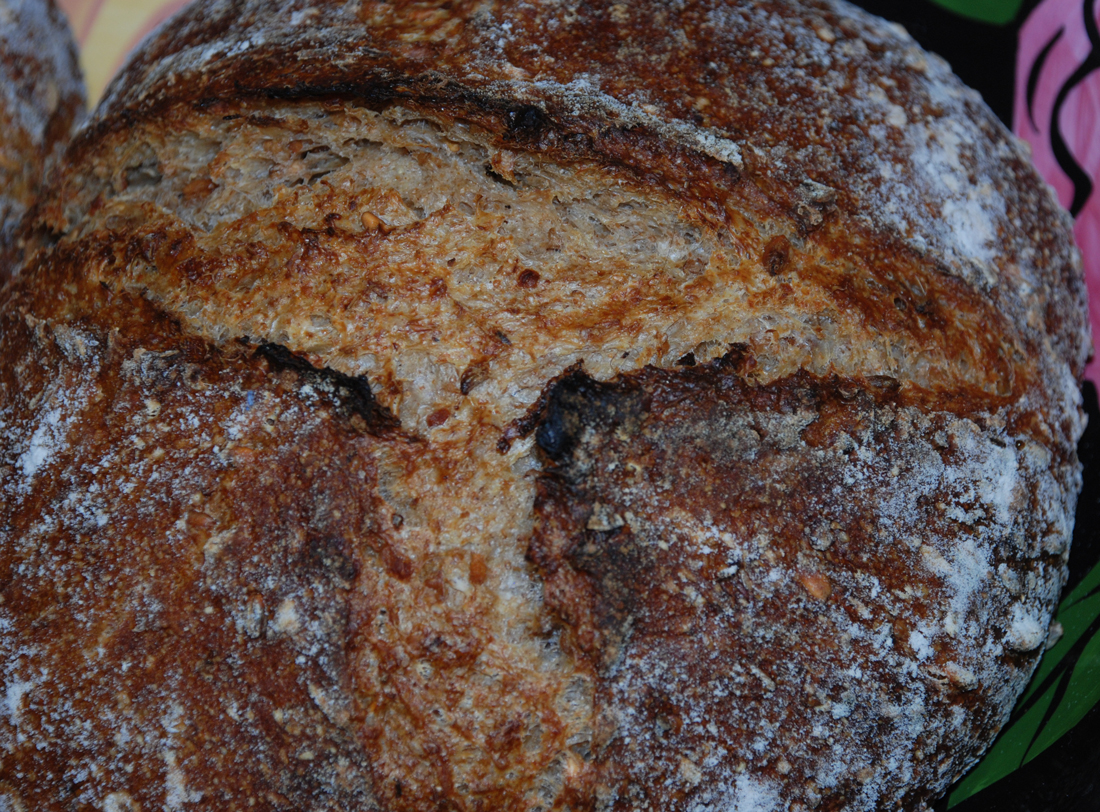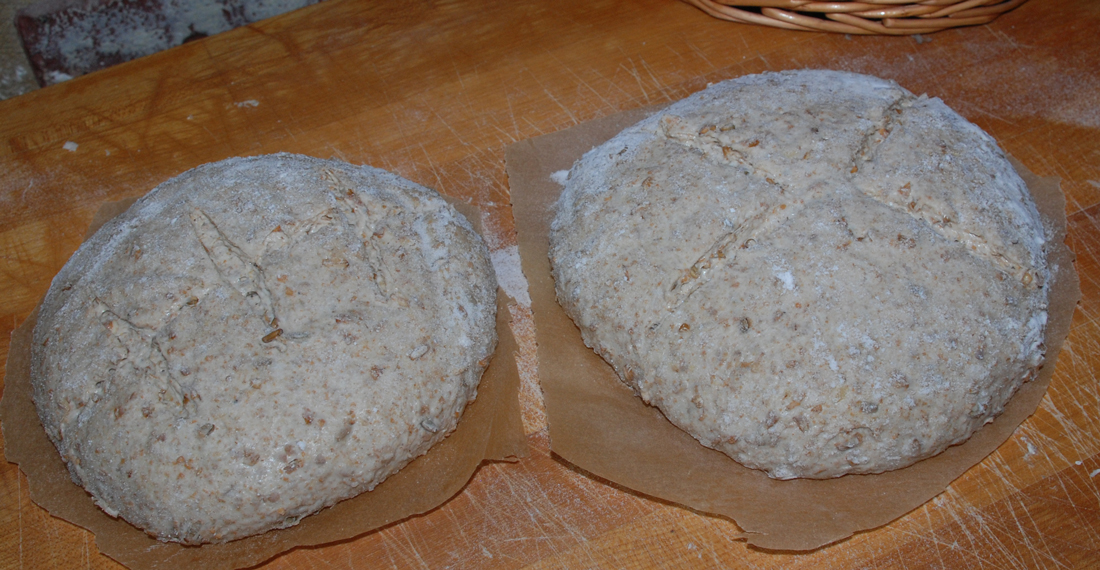 My first attempt this bread I concocted came out excellent with a nice moist open crumb and crisp crust. I decided it was time to try it again and change-up some of the flours and grains used in the soaker. I just picked up some Bulgar Wheat so I decided to add that to the soaker along with rolled oats, malt rye berries, oat bran and cracked wheat. I also used a different mix of flours including spelt which has become one of my favorites due to its nutty flavor. I used pumpernickel flour instead of medium rye as well.
My first attempt this bread I concocted came out excellent with a nice moist open crumb and crisp crust. I decided it was time to try it again and change-up some of the flours and grains used in the soaker. I just picked up some Bulgar Wheat so I decided to add that to the soaker along with rolled oats, malt rye berries, oat bran and cracked wheat. I also used a different mix of flours including spelt which has become one of my favorites due to its nutty flavor. I used pumpernickel flour instead of medium rye as well.
In trying to calculate the bakers percentages for this recipe I included all the water from the soaker, final dough and also the water from my refreshed 65% hydration AP starter. When I calculated the water from the starter it also included the water from the seed starter which I'm not sure it that is necessary or not, but the overall hydration of this dough ended up being 86%. If you are not comfortable with wet doughs, you may not want to try this one. I do have to say that a lot of the water is absorbed by the soaker so it's not really as wet as it sounds.
If you venture to try this, please let me know how your attempt comes out.
Ingredients
Soaker
28 Grams. Rolled Oats
57 Grams Malted Rye Berries
57 Grams Bulgar Wheat
28 Grams Oat Bran
28 Grams Cracked Wheat
359 Grams Boiling Water
Final Dough
425 Grams White Starter recently refreshed
98 Grams Whole Wheat Flour
86 Grams Pumpernickel Rye Flour
28 Grams Spelt Flour
144 Grams First Clear Flour (you can substitute bread flour or High Gluten Flour)
14 Grams (2.5 Tsp) . Seas Salt or Table Salt (Note: I usually use 2.5 Tsps. of salt, but I have started to weigh the salt which ended up being 14 grams. According to my conversion program it should be 18 grams)
173 Grams Water, 90 degrees F.
Directions
Mix all ingredients for soaker in a bowl and add boiling water. Let it sit for 2-3 hours covered until the grains are soft.
After 2-3 hours add the soaked grains along with the remaining liquid in your mixing bowl and add the flours, salt and remaining water and mix for 2 minutes. The dough should come together in a shaggy mess and should be relatively moist at this point. Let it rest for 5 minutes and mix for 4 minutes more on medium low-speed.
Remove dough from mixing bowl to work surface and do a stretch and fold. You may need to wet or oil your hands and the work surface since the dough will still be very sticky at this point. Form the dough into a ball and let it rest uncovered for 10 minutes. Let the dough rest uncovered for 10 minutes. After 10 minutes do another stretch and fold and cover the dough with a moist lint free towel or plastic wrap sprayed with non-stick cooking spray. Do another stretch and fold two more times letting the dough rest 10 minutes each time. After the last stretch and fold put the dough into an oiled bowl and cover it tightly.
Let the dough sit in your bowl for 2 hours at room temperature. It should only rise slightly at this point. After the 2 hours are up put in your refrigerator for at least 12 hours or up to 3 days.
When ready to bake the bread take your bowl out of the refrigerator and let it sit at room temperature for around 2 hours. After 2 hours shape the dough as desired being careful not to handle the dough too roughly so you don't de-gas it.
Place it in your bowl, banneton or shape into baguettes.
Let it sit at room temperature for 2 hours covered with oiled plastic wrap or a moist cloth.
Pre-heat oven with baking stone (I use one on bottom and one on top shelf of my oven), to 500 degrees F.
Slash loaves as desired and place empty pan in bottom shelf of oven.
Pour 1 cup of very hot water into pan and place loaves into oven.
Lower oven to 450 Degrees and bake for 25 - 35 minutes until bread is golden brown and internal temperature reaches 200 degrees.
Shut the oven off and leave the bread inside with the door slightly open for 10 minutes. This will help dry the loaves out and keep the crust crunchy.
Let cool on cooling rack and enjoy!
Feel free to visit my other blog to see some of my older posts at www.mookielovesbread.wordpress.com
- Isand66's Blog
- Log in or register to post comments





Mmmmm… lots a whole grain goodies in a beautiful loaf. Nice!
Marcus
Thank you Marcus
That looks delicious to me. I love the grains, the crumb and the caramelized, dark crust. Healthy and scruptious all in one!
Janie
Thanks Janie.
It really does taste great for such a healthy bread.
Ian
SD yet Ian. What a great mix of hearty grains. The crust and crumb are just about the best I have seen you produce. So how did you build to such a huge 425 g white starter? I'm definately going to butcher this one someway - somehow!
What a great job.
Thanks DA
I was very pleased with results.
After your Multigrain Challah I'm sure you can manage this one just fine.
Regards Ian
In regards to the starter, I gave you the directions to make the exact amount of starter used, however I usually use my mother starter and refresh it by adding 299 grams of AP flour, 105 grams seed starter and 194 grams of water.
I leave this overnight for around 9-10 hours and put in the refrigerator until ready to bake that evening or the next day. You can of course use your stock starter, just adjust the water as needed. My mother starter is around 65% hydration.
P.S. I sent you a email regarding the calculator program you sent me. If you get a chance give me a shout via email or here regarding my questions. Thanks for sending me your spread sheets.
getting some good results with these large levain builds of yours. You are on to something - good don't you think?
I'm following the lead of Peter Reinhart from his last book ABED. I find this technique works very well and allows for long fermentation times in the fridge. You should give it a try and see if you like it.
Love the mix of grains and the beautiful last photo, with the open crumb and rustic crust. Very, very nice.
Thank you very much.
Appreciate the compliments. I hope you give it a try one day.
Regards
Ian
Hi, I would like to make this bread: what are malted Rye berries? Is it necessary? I am thinking just throw together what I have in my pantry?
Thanks Bread Basket.
Rye berries are used to grind into rye flour.
You can substitute any whole grain you have like barley, millet erc.
Let me know how it turns out for you.